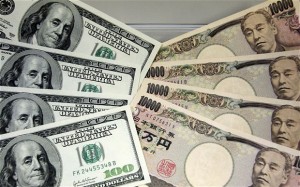 US dollar edged lower against the Japanese yen on Friday, following a vast set of economic data, released out of Japan, which to an extent confirmed Bank of Japans view that nations economy was recovering at a moderate pace.
US dollar edged lower against the Japanese yen on Friday, following a vast set of economic data, released out of Japan, which to an extent confirmed Bank of Japans view that nations economy was recovering at a moderate pace.
USD/JPY slipped to a session low at 102.18 at 5:15 GMT, after which consolidation followed at 102.24, losing 0.06% for the day. Support was likely to be found at November 28th low, 101.94, while resistance was to be seen at May 23rd high, 103.56.
According to a report, the annualized index of consumer prices in Japan reached 1.1% in October, confirming the rate shown a month ago and also meeting preliminary estimates.
The index of consumer prices, excluding prices of fresh food, the Bank of Japan’s gauge for its 2% inflation objective, rose to 0.9% in October on annual basis, in line with expectations, marking its fifth consecutive gain and also the fastest pace since November 2008, after in September it reached 0.7%.
The annualized consumer price index (CPI) for Ku-area of Tokyo climbed to 0.9% in November from a year earlier, exceeding preliminary estimates of a 0.7% inflation, while in October the CPI rose to 0.6%.
These data points suggested that Japan was in a process of recovery from the 15-year period of deflation. Bank of Japan has been purchasing more than 7 trillion JPY (68.4 billion USD) of government bonds each month in its struggle to achieve 2% inflation in two years since April.
“The yen selling may have been triggered by inflation data out of Japan,” said Minori Uchida, the Tokyo head of global market research at Bank of Tokyo-Mitsubishi UFJ Ltd., a unit of Japan’s biggest financial group by market value, cited by Bloomberg News. “The market is taking note of Japan’s exit out of deflation. The yen may test 103 per dollar with the May high in sight.”
A separate report showed that Japanese industrial output rose 0.5% in October compared to September, or a second monthly increase, but however, the result was below forecasts of a 2.0% gain. In September compared to August production grew 1.3%.
According to Japanese Department of Economy, manufacturers in the country predict that their production will increase 0.9% in November and 2.1% in December. Manufacturing output is a key component of the overall industrial output in Japan.
In addition, the seasonally adjusted unemployment rate in the country remained steady at 4.0% in October, while projections pointed a decrease to 3.9%.
A survey revealed that households in the country were more cautious making purchases, with the index, which gauges spending, increasing 0.9% in October 2013 compared to October 2012, after in September the index expanded 3.7%.
The above mentioned data string came one day after it became clear, that annualized retail sales in Japan rose 2.3% in October, marking a third consecutive year-to-year increase, above preliminary estimates of a 2.2% gain. September’s rate of increase has been revised down to 3.0% from 3.1% previously. On a monthly basis, however, retail sales dropped 1.0% in October, following a 1.7% gain in September.
Meanwhile, the Institute for Supply Management (ISM) will probably say that its index of manufacturing activity fell to a value of 55 in November from 56.4 in the preceding month, which was the highest level since April 2011, according to the median estimate of economists participated in a survey by the same media. The official report is scheduled for release on December 2nd.
Elsewhere, the Japanese yen was steady against the euro, with EUR/JPY cross dipping 0.02% on a daily basis to trade at 139.19 at 8:25 GMT. GBP/JPY pair was losing 0.10% today to trade at 167.10 at 8:26 GMT.
The yen has plunged 19 percent over the past 12 months, or the worst performing currency among the 10 developed-nation currencies, which are tracked by Bloomberg Correlation-Weighted Indexes. The euro has demonstrated the best performance within the group during the same period, appreciating 8.6 percent, while the US dollar has risen 3 percent.





